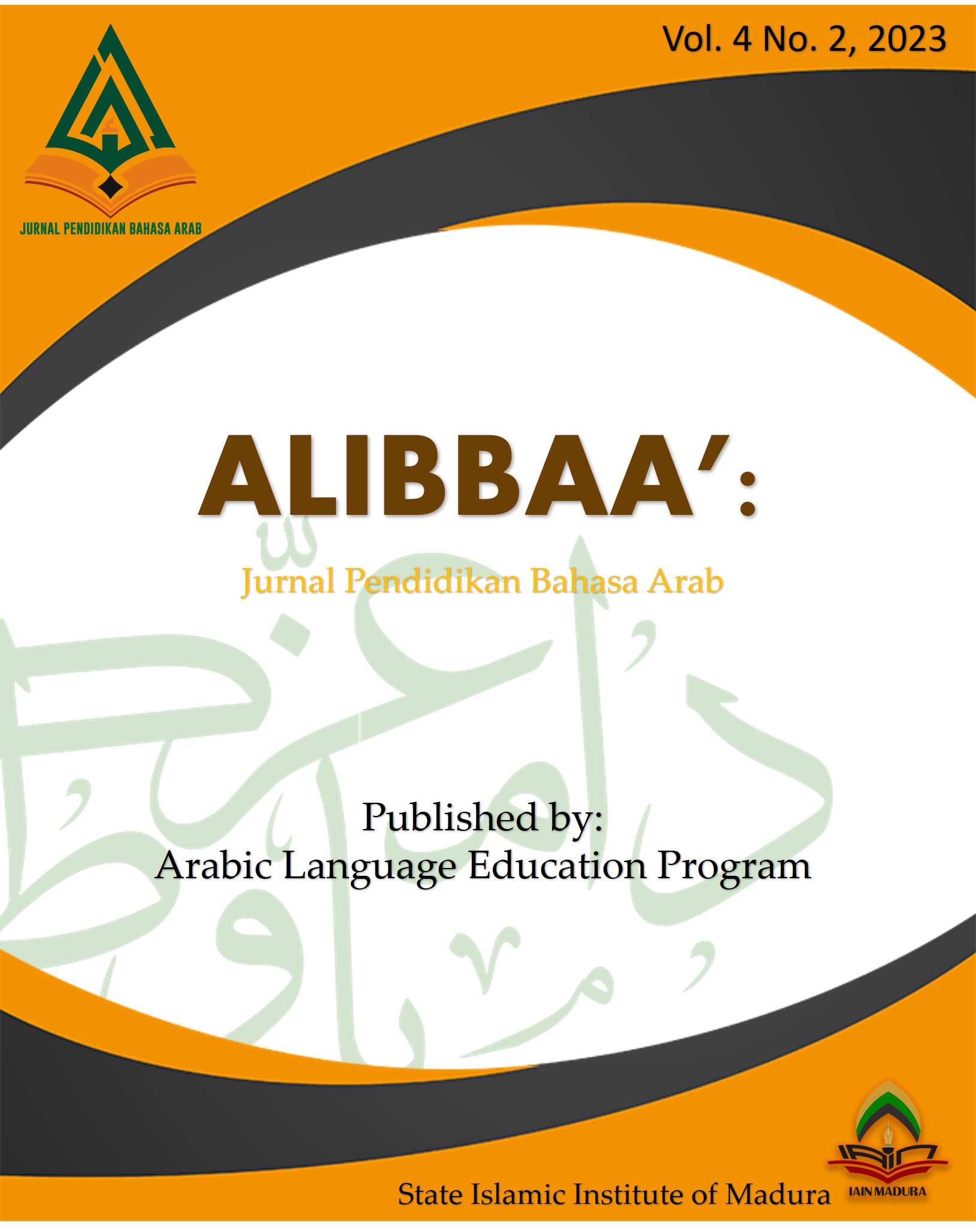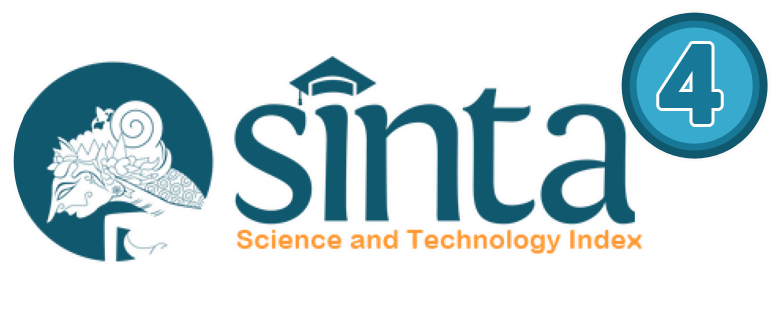The Development of Modern Arabic in Syntactic and Semantic Perspectives in Alarabiya Magazine
 Abstract views: 342
,
Abstract views: 342
,
 pdf downloads: 382
pdf downloads: 382
Abstract
The purpose of this study is to investigate the modern Arabic language used by Alarabiya online. The focus of this research is on the analysis of the development of meaning and language structure, with the object of research being the online magazine Alarabiya. This study employs lexical, grammatical, and contextual analysis of meaning, as well as syntactic research by analyzing phrases, clauses, and verbs. The theory used in this research is al-Nazhariyyah al-Siyaqiyyah or contextual theory developed by J.R Firth. The research method used is a literature review with two approaches, namely sociolinguistics and lexical statistics. The primary data source in this research is the online magazine Alarabiya. The results of this research indicate that the modern Arabic language used by Alarabiya magazine has undergone many developments in meaning and structure, and has been influenced by the development of science and technology in various fields such as politics, economy, science, and technology.
Downloads
References
'Afif, Muhammad al-Din Dimiyati. Muhâdarah Fî Ilm al-Lughah al-Ijtimâ’i. Surabaya: Dar- ‘Ulum Al-Lughawiyah, 2010.
Abd, Khamis Allah al-Tamimi. “Al-Rahmâh Baina al-Dalâlah al-Mu’jamiyah Wa al-Dalâlah al-Siyâqiyah Fî al-Isti’mal al-Qurâni”, Journal al-Adâb Vol. 106, 2018.
Ahmad, Klalil ‘Amariyah. Fî al-Tahlîl al-Lughawi. Kairo: Maktabah al-Manar, 1987.
al-Gaffar, Abd Ruskhan. Bahasa Arab Dalam Bahasa Indonesia: Kajian Tentang Pemungutan Bahasa. Jakarta: PT Grasindo, 2007.
al-Kuli, ‘Ali. A Dictionary of Applied Linguistics. Beirut: Maktabah Du Liban, 1986.
al-Mu’is, Abd Ba’dulu. Morfosintaksis. Jakarta: PT Rineka Cipta, 2005.
al-Rahman, Taufiq. Leksikologi Bahasa Arab. Malang: UIN Malang Press, 2008.
Aslinda dan Leni Syafyahya. Pengantar Sosiolinguitik. Bandung: Refika Aditama, 2007.
C, Karin Ryding. A Reference Grammar of Modern Standard Arabic. Cambridge: Cambridge University Press, 2005.
Chaer, Abdul dan Leonie Agustina. Sosiolinguistik Perkenalan Awal. Jakarta: PT Rineka Cipta, 1995.
Chaer, Abdul. Linguistik Umum. Jakarta: Rineka Cipta, 2003.
Chaer, Abdul. Pengantar Semantik Bahasa Indonesia. Jakarta: PT Renika Cipta, 1995.
Chair, Abdul. Kajian Bahasa: Struktur Internal, Pemakaian dan Pembelajaran. Jakarta: Rineka Cipta, 2013.
Data Majalah Alarabiya Edisi Agustus 2015.
Data Majalah Alarabiya https://english.alarabiya.net/media/television-and-radio/2018/03/29/ Edisi Desember 2015.
Data Majalah Alarabiya https://english.alarabiya.net Edisi Juni 2016.
Hasan, Muhammad ‘Abd al-‘Aziz. Tatawûr al-Lughah al-Arabiyah: Pembahasan Lembaga Bahasa Mengenai Asal Kata, Lafaz, dan Uslub. Kairo: Maktabah al-Adab, 2014.
Ibrahim, Shabri al-Said. ‘Ilm al-Lughah al-Ijtimâ’i : Mafhumuhu wa Qadhâyâhu. Aleksandria: Dar al-Ma’rifah, 1995.
M, Anton Moeliono. Perkembangan dan Pembinaan Bahasa: Ancangan Alternatif di dalam Perencanaan Bahasa. Jakarta: Djambatan, 1985.
Markhamah. Ragam dan Analisis Kalimat Bahasa Indonesia. Surakarta: Muhammadiyah University Press. Matsna, Moh. Kajian Semantik Arab Klasik dan Kontemporer. Jakarta: Kencana, 2016.
Mukhtar, Ahmad Umar. Mu’jam al-Lughah al-‘Arabiyah al-Mu’âshirah. Kairo: ‘Alim al-Kutub, 2008.
Muslich, Masnur dan I Gusti Ngurah Oka. Perencanaan Bahasa Pada Era Globalisasi. Jakarta: Bumi Aksara, 2010.
Parera, J.D. Teori Semantik Edisi Kedua. Jakarta: Erlangga, 2004.
Pateda, Mansoer. Linguistik Sebuah Pengantar. Bandung: Angkasa Bandung, 2015.
Pateda, Mansoer. Semantik Leksikal. Jakarta: PT Rineka Cipta, 2001.
Samsuri. Analisis Bahasa. Jakarta: Erlangga, 1987.
Aziz. Abd. “BAHASA ARAB MODERN DAN KONTEMPORER; KONTINUITAS DAN PERUBAHAN”. Jurnal Mumtäz Vol. 3 No. 1, Tahun 2019. https://doi.org/10.36671/mumtaz.v3i2.38
Islamy, A. “Existence EXISTENCE OF NAHT METHOD IN THE DEVELOPMENT OF CONTEMPORARY ARABIC LANGUAGE”. Taqdir, Vol 5 No. 2, 19-28. https://doi.org/https://doi.org/10.19109/taqdir.v5i2.4926. 2019.
Taufiq Hidayat Pabbajah. M. “Orientalist Construction on the Existence of Ammiyah Arabic in Egypt in the 20th Century”. The associatin for Arabic and English. Vol 6. No. 2. 2020. http://dx.doi.org/10.31332/lkw.v6i2.1962.
Almog Kasher. “PEDAGOGICAL CONSIDERATIONS AND TERMINOLOGICAL CONVENTIONS IN ARABIC GRAMMATICAL TRADITION: THE TERM JUMLA REVISITED”, International Jurnal of Arabic Linguistics Vol. 9, 2023. https://revues.imist.ma/index.php/IJAL/article/view/39470/20384.
Hicham Ouardi. “THE ROLE OF SONORITY CYCLES IN THE AUTOMATIC RECOGNITION OF FORMAL LEXICAL BORROWINGS IN ARABIC”, International Jurnal of Arabic Linguistics Vol. 9, 2023. https://revues.imist.ma/index.php/IJAL/article/view/39470/20384.
Ahmed Ech-charfi. “THE RECEPTIVE VOCABULARY SIZE OF MOROCCAN LEARNERS OF MODERN STANDARD ARABIC”, International Jurnal of Arabic Linguistics Vol. 9, 2023. https://revues.imist.ma/index.php/IJAL/article/view/39470/20384
Mohammed Shormani. “IMPERATIVES IN ARABIC: SYNTAX, DISCOURSE AND INTERFACE”, International Jurnal of Arabic Linguistics Vol 7, No 1, 2021. https://revues.imist.ma/index.php/IJAL/article/view/39470/20384
Rashid Al-Balushi. " مراجعات في نحو اللغة العربیة", International Jurnal of Arabic Linguistics Vol 6, No 1-2, 2020. https://revues.imist.ma/index.php/IJAL/article/view/39470/20384
Fitriani. “Fungsi, Kategori, dan Peran Sintaksis Bahasa Arab: Perspektif Linguistik Modern”, International Conference on Education, Islamic Studies, and Local Wisdom (ICEIL), Vol 1, No 1, 2022. https://doi.org/10.46870/iceil.v1i1.473.
Khabib Akbar Maulana, Moh. Masrukhi. “PERAN SINTAKSIS AJUNG AKUSATIF BAHASA ARAB DALAM KITAB NASHĀ`IḤUL-‘IBĀD: TINJAUAN TATA BAHASA PERAN DAN RUJUKAN”, Jurnal CMES, Vol XIV, No 1, 2021. https://doi.org/10.20961/cmes.15.1.49604
Anang Ramadlon, Hasan Busri. “MUBTADA’ (TOPIC) DAN KHABAR (COMMENT) DALAM KITAB SAFINATUN NAJAKARYA SYEIKH SALIM BIN ABDULLAH BIN SAID BIN SUMAIR AL HADRAMIY (ANALISIS SINTAKSIS)”, Journal of Arabic Learning and Teaching Vol 10, No 2, 2021. https://doi.org/10.15294/la.v10i2.51939.
Khamimah, Nafis Azmi Amrullah. “ANALISIS SINTAKSIS KONTRASTIF NOMINA DALAM BAHASA ARAB DAN BAHASA INDONESIA”, Journal of Arabic Learning and Teaching Vol 11, No 2, 2022. https://doi.org/10.15294/la.v10i2.51939.
Sulaiman Ismail, Yuslina Mohamed. “Analysis of Arabic Syntactic Errors in Essays among Native Students of Malay Language”, INTERNATIONAL JOURNAL OF LANGUAGE EDUCATION AND APPLIED LINGUISTICS (IJLEAL), Vol 11, 2021. https://doi.org/10.15282/ijleal.v11.5231.
Anisatu Thoyyibah. “Analisis Kesalahan Ortografi Bahasa Arab Mahasiswa Pendidikan Bahasa Arab Universitas Muhammadiyah Malang”, Arabiyatuna. Jurnal Bahasa Arab, Vol 3, No 2, 2019. http://garuda.kemdikbud.go.id/article.php?article=2325342&val=10809&title=Analisis%20Kesalahan%20Ortografi%20Bahasa%20Arab%20Mahasiswa%20Pendidikan%20Bahasa%20Arab%20Universitas%20Muhammadiyah%20Malang.
S. Sulaikho and L. Mathoriyah. “ANALISIS PERMASALAHAN MAHASISWA DALAM MEMPELAJARI SINTAKSIS BAHASA ARAB”, JURNAL EDUCATION AND DEVELOPMENT, Vol. 8, No. 3, 2020. https://doi.org/10.37081/ed.v8i3.1921.
Al-Rubaat, Atalah Mohammad. “The Relationship between the Morphological Phenomena of the Current Sakakan Dialect and the Modern Standard Arabic”, Eurasian Journal of Applied Linguistics, Vol 8, No 1, 2022. https://eric.ed.gov/?id=EJ1341554.
Arfan Ahmed, Nashva Ali. “Arabic chatbot technologies: A scoping review”, Computer Methods and Programs in Biomedicine Update, Vol 2, 2022. https://doi.org/10.1016/j.cmpbup.2022.100057.
Ruslan Ruslan, Najamuddin Abd Safa. “Perkembangan Makna Bahasa Arab: Studi Fenomena Semantik dalam Al-Qur’an”, Jurnal Pendidikan dan Konseling, Vol 5, No 1, 2023. https://doi.org/10.31004/jpdk.v5i1.10942.
Nelis Jamilah Ilmiatun, “Perkembangan Makna Bahasa Arab”, Diwan Jurnal Bahasa dan Sastra Arab, Vol 14, No 2, 2022. https://doi.org/10.15548/diwan.v14i2.826.
Neldi Harianto, Rengki Afria. “The History of the Development and Growth of Arabic Language Science”, INTERNATIONAL CONFERENCE OF MALAY IDENTITY (ICMI) VII, Vol 3, 2022. http://www.conference.unja.ac.id/ICMI/article/view/180
Ilya Husna, Hidayati Azkiya. “The Analysis of Arabic Language Textbooks for Class II Elementary School”, Lectura Jurnal pendidikan, Vol 13, No 2, 2022. https://doi.org/10.31849/lectura.v13i2.10417.
Jamal Syahlan, Arie Machlina. “The Development Of The Meaning Of Absorption Words From The Arabic Language Into The Indonesian Language”, Journal International Seminar on Languages, Literature, Arts, and Education (ISLLAE), Vol 4, No 1, 2022. https://doi.org/10.21009/ISLLAE.04106.
Rifda Amalia, Muhammad Afthon Ulin Nuha. “Development of Kosbarab Learning Media to Improve Arabic Vocabulary Mastery of Elementary Level Students Based on Android Construct 2”, Al-Ta’rib, Vol 10, No 2, 2022. https://doi.org/10.23971/altarib.v10i2.4529.
Raoul Villano. “Musnad, Musnad ʾilayhi and Commentaries on the Kitāb of Sībawayhi: Transmission and Development of Grammatical Knowledge between 2nd/8th and 5th/11th Centuries”, International Jurnal of Arabic Linguistics Vol 6, No 1-2, 2020. https://revues.imist.ma/index.php/IJAL/article/view/21986.
Yahya Dkhissi, Amina Boutabia. “A Shell Structure Account of Pseudogapping in Standard Arabic and Moroccan Amazigh Construct States”, International Jurnal of Arabic Linguistics Vol 6, No 1-2, 2020. https://revues.imist.ma/index.php/IJAL/article/view/21986.
محمد قصبي, عبد الحمید الجیھاد. " نحو بناء موارد لسانية لبلورة محلل تركيبي للجملة العربية"، International Jurnal of Arabic Linguistics Vol 6, No 1-2, 2020. https://revues.imist.ma/index.php/IJAL/article/view/21986.
Ahmad Al-Jallad, “The Classification of the Languages of North Arabia: Remarks on the Semitic Language Family Tree of the 2nd edition of Routledge’s The Semitic Languages”, International Jurnal of Arabic Linguistics Vol 5, No 2, 2019. https://revues.imist.ma/index.php/IJAL/article/view/21986
Maather M. Al-Rawi, “Are Adjectives Phrases Phases? Evidence from Arabic”, International Jurnal of Arabic Linguistics Vol 5, No 2, 2019. https://revues.imist.ma/index.php/IJAL/article/view/21986
Mohammed Ali Al-Malahmeh, Hamed Abdelhamiyd Aljeradaat. “An Alternative Semantic Analysis of the Particle ʃikil in Jordanian Arabic”, Internatinonal Journal of Arabic-English Studies, Vol 23, No 1, 2023. https://doi.org/10.33806/ijaes2000.23.1.16%20.
Reima Al-Jarf. “Semantic and Syntactic Anomalies of Arabic-transliterated Compound Shop Names in Saudi Arabia”, International Journal of Arts and Humanities Studies, Vol. 3 No. 1, 2023. https://orcid.org/0000-0002-6255-1305.
Ma Shuhan, Mohd Azidan Abdul Jabar. “Semantic Challenges Caused by Abbreviations of Arabic Economic and Business Terms for Undergraduates in China”, International Journal of Academic, Vol 11, No 1, 2022. http://dx.doi.org/10.6007/IJARPED/v11-i1/11937.
Meliboyeva, Marhabo. "WEAK VERBS USED IN THE WORK AND THEIR STATISTICAL, MORPHOLOGICAL AND SEMANTIC ANALYSIS.", INTERNATIONAL JOURNAL OF SOCIAL SCIENCE and INTERDISCIPLINARY, Vol 11, No 9, 2022. http://gejournal.net.
Al-Jarf, R. “Issues in translating English and Arabic plurals”, The Journal of Linguistic and Intercultural Education-JoLIE, Vol 13, No 1, 2020. http://jolie.uab.ro/index.php?pagina=-&id=19&l=en.
Meliboyeva, Marhabo. "ARABIC VERB AND ITS TYPES.", Galaxy International Interdisciplinary Research Journal, Vol 10, No, 12, 2022. https://www.jstor.org/stable/43194089.
Authors who publish with this journal agree to the following terms:
a. Authors retain copyright and grant the journal right of first publication with the work simultaneously licensed under a Creative Commons Attribution License that allows others to share the work with an acknowledgement of the work's authorship and initial publication in this journal.
b. Authors are able to enter into separate, additional contractual arrangements for the non-exclusive distribution of the journal's published version of the work (e.g., post it to an institutional repository or publish it in a book), with an acknowledgement of its initial publication in this journal.
c. Authors are permitted and encouraged to post their work online (e.g., in institutional repositories or on their website) prior to and during the submission process, as it can lead to productive exchanges, as well as earlier and greater citation of published work (See The Effect of Open Access).
Alibbaa': Jurnal Pendidikan Bahasa Arab have CC-BY-SA or an equivalent license as the optimal license for the publication, distribution, use, and reuse of scholarly work.
In developing strategy and setting priorities, Alibbaa': Jurnal Pendidikan Bahasa Arab recognize that free access is better than priced access, libre access is better than free access, and libre under CC-BY-SA or the equivalent is better than libre under more restrictive open licenses. We should achieve what we can when we can. We should not delay achieving free in order to achieve libre, and we should not stop with free when we can achieve libre.

Alibbaa': Jurnal Pendidikan Bahasa Arab is licensed under a Creative Commons Attribution 4.0 International License
You are free to:
- Share — copy and redistribute the material in any medium or format
- Adapt — remix, transform, and build upon the material for any purpose, even commercially.
- The licensor cannot revoke these freedoms as long as you follow the license terms.











